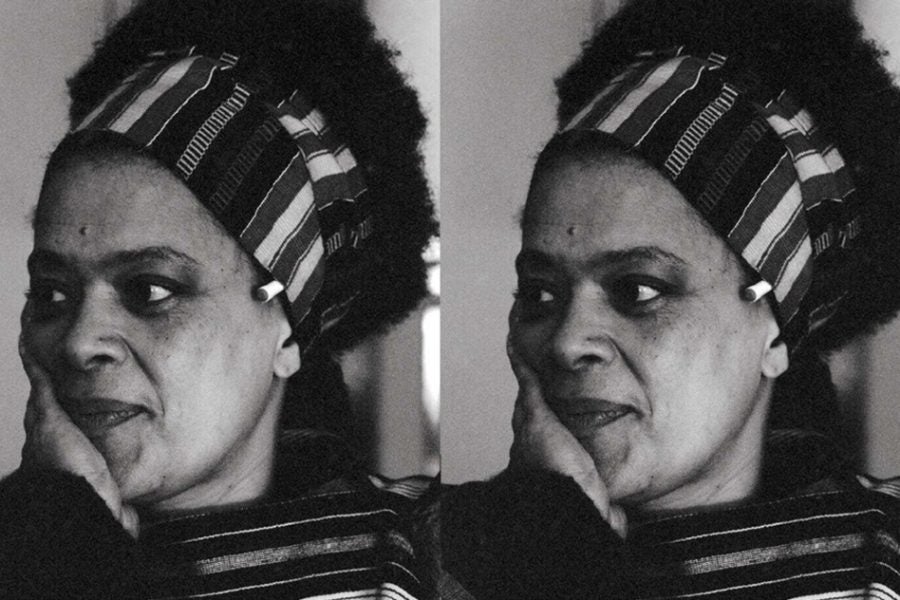A Timeline Of Black American Flags Throughout History

At its best, flags can be powerful symbols. Flags can represent pride, hope, resilience, history, and the future. At the worst, they are symbols of hate and can incite fear and trigger trauma. Regardless of the use, like language and culture, flags are a vital aspect to any group of people’s identity. Given the history of Black people in United States—ascending from chattel slavery to free American citizens—the journey to establishing an identity for ourselves has been laborious. As the Black identity is constantly changing, the icons that represent us have too.
Here is the growing list of flags that have sewn the Black experience into the fabric of American history:
01
Pan-African flag — 1920
Created by Marcus Garvey in 1920, the Pan-African flag is known to be the first flag for Black Americans. The Jamaican political activist and founder of the Universal Negro Improvement Association and African Communities League created the flag to combat racism.
It was in response to a hit song called “Every Race Has a Flag but the Coon,” which mocked and stereotyped African Americans. In 1927, Negro World published a 1921 speech from Garvey, stating, “Show me the race or the nation without a flag, and I will show you a race of people without any pride. Aye! In song and mimicry, they have said, ‘Every race has a flag but the coon.’ How true! Aye! But that was said of us four years ago. They can’t say it now.”
In 1921, the UNIA published the colors of the flags meaning: Red is the color of the blood which men must shed for their redemption and liberty; black is the color of the noble and distinguished race to which we belong; green is the color of the luxuriant vegetation of our Motherland. The Pan-African flag extends beyond the Black American experience as the colors would appear in newly liberated nations like Saint Kitts and Nevis, Kenya, South Sudan, Libya, Angola, Biafra, and Malawi.
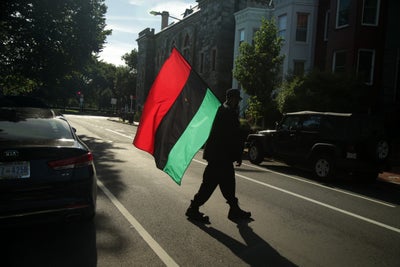
02
Black Panther Party flag — 1966
In 1966, comrades Huey Newton and Bobby Seale founded the Black Panther Party for Self-Defense in Oakland, California. That same year, Newton and Seale met SNCC leader Stokely Carmichael, who championed the call for “Black Power” at a conference. At the time, Carmichael was promoting the armed organizing efforts of the Lowndes County Freedom Organization (LCFO). The LCFO’s logo was black panther. According to Red Wedge magazine, Lowndes County had extremely conservative right-wing politics fueled by white racists. Due to high illiteracy rates, the white racists of Lowndes were able to go to court to get a symbol of a rooster put on the ballot so illiterate whites would know how to vote for without even being able to read or write. Black people in the town did the same thing; they chose a local varsity mascot of a black panther. Newton and Seale adopted the black panther from Carmichael. However, the panther from Lowndes was too fat for the duo. Newton and Seale asked one of their early recruits, a student-artist, Emory Douglas to redraw the Panther symbol smaller to reflect that the party was about serving the underserved and undernourished.
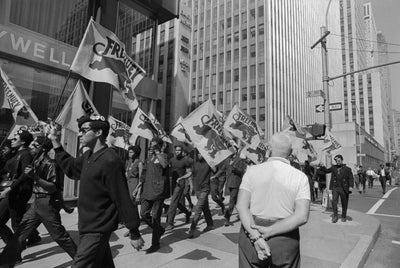
03
Black American Heritage Flag — 1967
Melvin Charles and Gleason T. Jackson designed the Black American Heritage Flag in Newark, New Jersey. The inspiration was purely birthed out of a lack of representation during parades and not identifying with the American flag. Charles told PBS, that the gold blunted sword invoked pride and the fig wreath symbolized peace, prosperity, and everlasting life. Following the UNIA, the red represents the bloodshed of Black people, and the black represented the pride in black pigmentation.
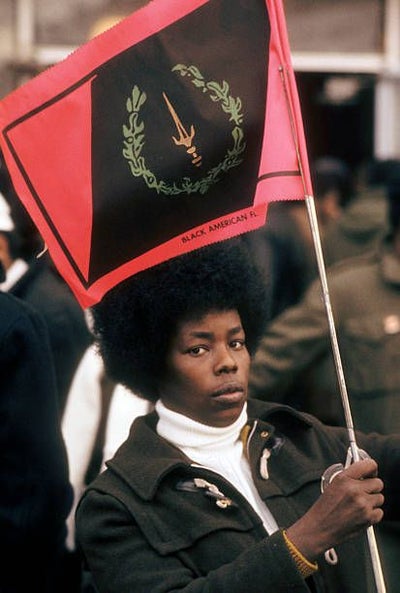
04
Juneteenth Flag — 1977
With the assistance of illustrator Lisa Jeanna, the Juneteenth flag was created in 1977 by activist Ben Haith, founder of the National Juneteenth Celebration foundation. The red, white, and blue color scheme is a direct homage to both the American flag and the Texas (Lone Star State) flag. Split between a blue and a red stripe, the two colors are meant to replicate a horizon. Blue above and the red is symbolic of the ground soaked with blood; the blood which was shed by the African American slaves for the United States. The white five-pointed star inside of a 12-point star, represents a nova, to symbolize the birth of a new star. The new star symbolizes a new beginning for the newly freed African Americans.
The flag was updated in 2007 by Haith to include the date, June 19, 1865, marking the last of the enslaved to be freed.
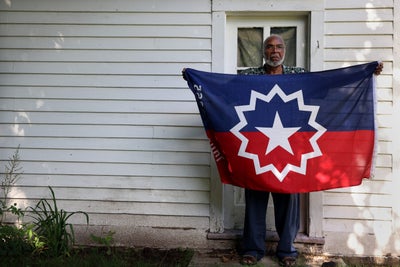
05
13 Stripes — 1989
Little can be found about this flag. However, it did appear in Louis Cameron’s “The African American Flag Project.” The 2009 exhibit was a suite of paintings of African American flags with the purpose to explore the dialogue of symbolic representation within the African American community. According to an online archival catalogue, the 13 stripes flag was developed in 1989 in South Central L.A. It is believed to be a private venture. One could argue that the 13 stripes represent either the original colonies of America, or the 13th amendment which abolished slavery. Much of the red, black, and greens colors are universal with the Pan-African ideology. The yellow or gold stripes might represent the richness of Black people, or the gold from African mines.
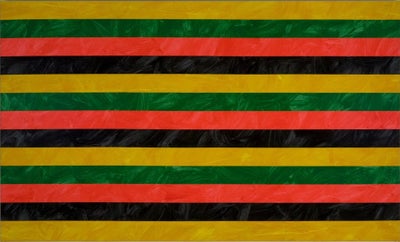
06
David Hammons’ African-American Flag — 1990
David Hammons African American flag was first created for the art exhibition “Black USA” at an Amsterdam museum in 1990. The flag is exactly what one would think of for the Black version of the American flag. Smithsonian magazine reported Hammons: “Marcus Garvey designed the African American flag, which looked like the Italian flag except that it is red, black, and green. But it is so abstract, so pure, that the masses were frightened by it. I made my flag because I felt that they needed one like the U.S. flag but with black stars instead of white ones.”
Hammons seamlessly captures the double consciousness of the Black identity within an American experience. His rendition of the American flag caused great controversy. Just the year prior, Congress passed the Flag Protection Act, authorizing penalties to those that desecrated the flag. But, by 1990, the Supreme Court ruled that the Flag Protection Act was unconstitutional, as it violated free speech rights.
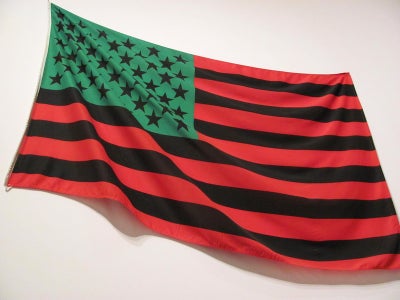
07
The Harvey African-American Flag — 1991
David and Tonya Harvey created a flag in 1991 to represent the African-American population as a whole, but not connected to any political movement. The idea sparked during a banquet while attendees sang the Negro National Anthem. The couple noticed everyone’s eyes were adverted everywhere because there was a lack of a focal point. They developed the African-American Flag.
The red, white, and blue, stripes at the top and bottom border, represents African-American’s contributions to America. While Black people’s history on American soil is traumatic, there is an undeniable connection to this country. There are green, yellow, and black stripes on the side borders, the abundant life in Africa; the riches of Africa; and of course, the regality of African skin. The purple base of the flag represents the regal history of African-Americans. The eight-pointed black star in the center of the flag represents the eight letters in the word Africans—which is an acronym: Aspirations, Family, Righteousness, Individuality, Community, Ability, Nobility, and Scholarship. Outside of the black eight-pointed star, are four yellow diamond shapes, meant to symbolize flashes of light, for perseverance, love, knowledge, and spirituality. Harvey’s widow told Morgan Magazine in 2002, “He wanted the flag to help pull African Americans together…and to remind us that each one of us can succeed and do well.”

08
NuSouth — 1993
In the same vein of reappropriating negativity to reclaim power, in 1993, a Charleston, South Carolina clothing company, called NuSouth Apparel, remixed the confederate flag. Founders Angel Quintero and Sherman Evans plotted a marketing scheme for a local hip-hop group, DaPhlayva, to push Southern rap identity to the forefront amidst the brewing coastal beef between the East and the West. Much like Hammons’ African-American flag, the NuSouth flag pulled from Garvey’s Pan-African color scheme. The NuSouth presented three different variations of the confederate flag, one with a red background, another in black, and a third with green. Each of which also alternated the colors for the stars and bars. Controversy propelled the brand forward when a teenaged Black girl was suspended for wearing a NuSouth shirt to school. The principal said it was the wrong colors.
The flag quickly became a symbol of rebellion in the ’90s—it can be seen in footage from the Million Man March on Washington, D.C. in 1995. The duo even went as far as proposing that the South Carolina State House replace the Confederate flag with the NuSouth flag. The NuSouth brand went under in 2003. However, the two can still be found curate the brand’s history on social media. In 2020, Evans addressed the usage of polarizing imagery stating, “There is a lot of fear in something that is so liberating and free… People say they want freedom but what does that look like?”

09
African-American Flag House Flag — 1995
The African American Flag House created their flag between 1993 and 1994 in Charleston, South Carolina. According to the archived website, the Foundation hoped that the flag would become “a positive and unifying symbol that would represents the enormous historical investment of African Americans.”
The First Star announces that all humankind was born out of the womb of Africa. The Second Star informs with pride that the African gave rise to the first civilizations and kingdoms of the world. The Third Star depicts the cruel abduction of Africans from their original roots. The Fourth Star vows that African Americans will never forget the holocaust of the Middle passage and the millions of Africans who suffered and died during the terrible crossing.
The Fifth Star recalls the unholy bondage of African Americans prior to the abolishment of slavery in America. The Sixth Star praises all those African Americans who defied and rebelled against injustice and genocide in America. The Seventh Star is a memorial to African Americans who have silently or aggressively defended and preserved the Constitution of the United States of America. The Eighth Star recognizes the strength of the African American family and its inner spiritual belief in universal brotherhood. The Ninth Star is a testament to the strength and tenacity of African Americans to emerge victorious despite any adversity or challenge. The Tenth Star honors African Americans for their accomplishments in making the American dream a reality. The Eleventh Star calls for African Americans to probe their history and to celebrate their culture and heritage. The Twelfth Star signifies the achievements of African Americans through hard work, scholarship, and determination. The Thirteenth Star is the symbol of Pan African unity. The Fourteenth Star leads African Americans into the future with honor, truth, and the dream of a greater tomorrow.
The Green Stripes remind us of our living earth and the roots of all humanity buried deep in African soil. The Yellow Stripes symbolize the moral excellence and spiritual wealth of African Americans as they interact with all diverse cultures of America. The Black Stripes underscore African American families and their significant economic, spiritual, social, and political contributions to America. The White Stripes warn African Americans to be constantly vigilant of forces that call for death of freedom and the surrender of rights guaranteed to all by the Constitution of the United States of America. The Blue Stripes illustrate lofty skies that will always extend a bridge between African Americans and Africa. The Red Stripes tell of the passionate and soulful fire within the hearts of African Americans and that their blood shed in defense of freedom shall not be in vain.

10
African-American Flag of Inclusion — 1999
In 1999, the “African American Flag of Inclusion” was designed by Cecil W. Lee, a New York-based painter, photographer, and digital artist. He presented it at a one-man art show at Gallery X in Harlem. Lee’s rendition of the flag is a fusion of the American flag and Garvey’s Pan-African flag. By replacing the top seven stripes of the United States national flag with the Black Liberation flag pattern, Lee intended to represent “all African Americans regardless of their individual beliefs or political affiliations.” Per Lee’s website, he suggests, the elements of the African American Flag of Inclusion stand for: red is for life/blood, family, vitality & oneness, black is for the people, strength, depth, and influence. Green, represents earth, evolution, growth, and progress, while the stars and stripes represent equality and unification.
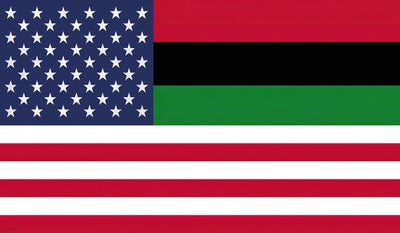
11
Black American Flag — 2003
This flag dates to as early as 2003. Proposed as the flag for African Americans or Black Americans population. The base of the flag is Black, meant to symbolize two aspects of the Black identity: the backbone of the history in America, rooted in slavery and unity toward social change. The lone white star in the top left corner is the North Star. While the North Star navigated our enslaved ancestors out of slavery, it can also guide Black Americans toward a better future.

12
Foundational Black Flag — 2020
Popularized online by controversial media personality, Tariq Nasheed, Foundational Black Americans are descendants of Black slaves who built the United States from the bottom. The movement is considered divisive for it’s anti-Pan-African sentiments. According to the website, FBAs believe that the origins and history of Black people in America did not begin at the start the Trans-Atlantic Slave Trade in the early 1600s. Instead, they propose that FBAs settled in North America in 1526, when they were allegedly brought over from the Caribbean by a “colonizer” named Lucas Vázquez de Ayllón.
FBAs have two flags. The first of which is a maroon flag with a gold emblem of two axes and a torch underneath five gold stars. The maroon color is a nod to the Maroon Africans, or Africans in American who formed settlements away from slavery—they are often mixed with Indigenous people. The torch and axes represent the weapons used to fight for freedom. The five stars represent the states where many maroon societies were established: Virginia, North/South Carolina, Florida, Mississippi, Louisiana.
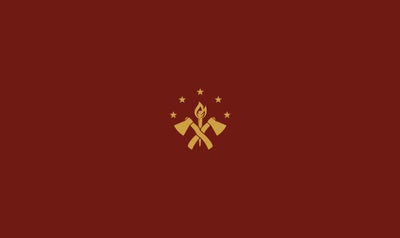
13
Foundational Black American flag — 2020
The second flag, possess the American color scheme, a nod to Grace Wisher, the free African American woman, who was indentured as a child to the famous Star-Spangled Banner flag seamstress, Mary Pickersgill. The three white stars represent the three ethnic groups that make up Foundational Black Americans: Black aboriginal people of North America, Black explorers and traders who explored the Americas before Columbus, and the captives brought to the Western Hemisphere from Africa. The center is the Black power fist from the 1960s. The red and blue olive branches represent the unity amongst Black aboriginals and Black enslaved people. The nine red pillars symbolize the significant slave rebellions, one of which is commonly hidden, hence why one of the red bars is behind the fist.
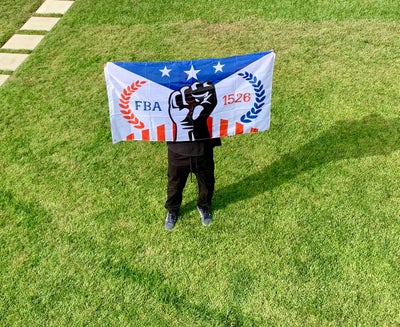
TOPICS: flags




